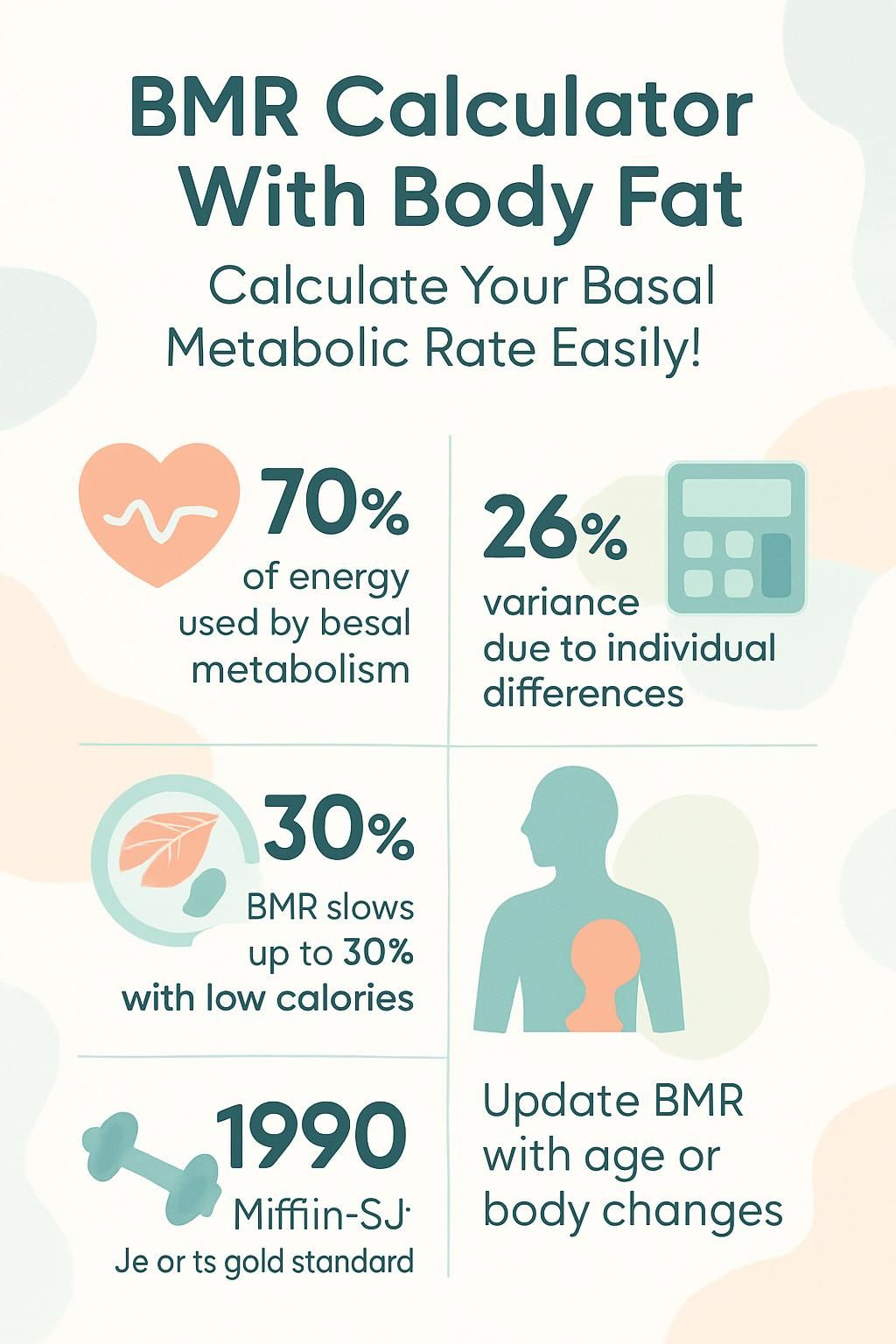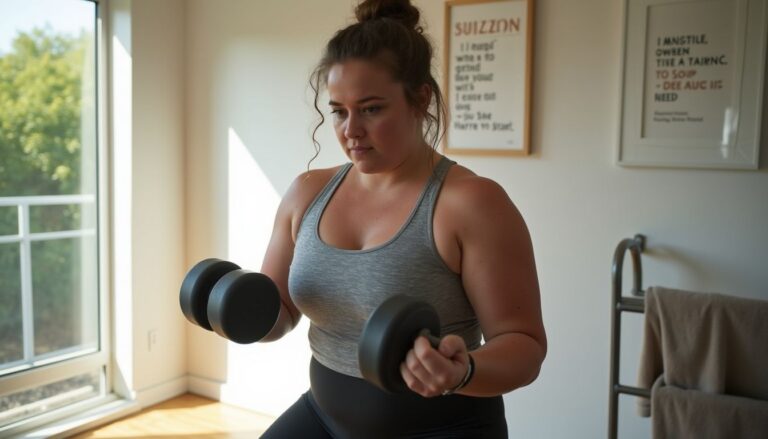BMR Calculator With Body Fat: Calculate Your Basal Metabolic Rate Easily!
Our Nutrition Assistant AI Suite will transform your body. You will lose fat, get toned, and build muscle. Gain confidence and optimal health.
Figuring out how many calories your body burns each day can feel confusing. I wanted a simple way to set targets for eating, weight loss, and muscle gain. After learning that basal metabolic rate, or BMR, drives most of daily energy use, I built a clear plan that starts with a reliable bmr calculator.
This guide shows how to estimate your basal metabolic rate with body fat data for better accuracy. I explain why BMR matters for your weight loss journey, which formulas fit different bodies, and how body fat percentage changes calorie needs. If you want practical steps to manage energy and reach goals, you are in the right place.
Key Takeaways
- BMR calculators that use body fat percentage, like the Katch-McArdle formula (BMR = 370 + 21.6 × lean mass in kg), are usually more accurate than weight-only methods.
- Basal metabolic rate makes up about 70% of daily energy use. Age, sex, muscle mass, and hormones can cause about a 26% difference between people.
- The Mifflin-St Jeor equation, first published in 1990, is widely seen as the gold standard for BMR estimation across ages and body types.
- Eating below your BMR for long periods can slow metabolism by up to 30%, increase muscle loss, and raise health risks.
- Recheck your BMR after changes in body composition or age so your calorie targets stay safe and effective.

What Is Basal Metabolic Rate and Why Does It Matter?

Basal metabolic rate is the number of calories your body needs at rest to stay alive. It covers breathing, heartbeat, organ function, and body temperature control. Knowing your BMR helps you set a realistic calorie budget and match it to your goals.
What Does Basal Metabolic Rate (BMR) Mean?
BMR stands for basal metabolic rate. It is the energy your body burns at rest in a neutral room after about 12 hours without food. My BMR shows how many calories I need to maintain vital functions, including breathing, heart work, organ activity, and temperature control.
Most people spend about 60% to 75% of their daily calories on these basic needs. That is why BMR is the largest part of your energy use.
BMR measures the minimum energy needed for life at rest. It does not include exercise or daily movement.
Scientists estimate BMR is roughly 70% of total daily energy expenditure. Knowing your basal metabolism separates resting needs from activity. It is a strong starting point for any plan.
How Does BMR Affect Your Health and Fitness?
A higher BMR means you burn more calories while resting. That often makes weight control easier. A 2005 analysis found about a 26% difference in BMR between people. This helps explain why two people can eat the same amount but see different results.
After I switched from guessing to using a BMR calculator with body fat, I set better calorie goals. My progress improved once I used research-backed equations instead of rough estimates. Since energy use guides results, it helps to see how body fat changes the numbers.
How Body Fat Influences BMR Calculations
Body fat percentage affects how many calories your body needs. I use my ratio of muscle to fat to estimate my BMR and then adjust my calorie intake and training plan.
How Does Body Fat Percentage Impact BMR?
Higher body fat often lowers BMR because fat tissue burns fewer calories than lean tissue, such as muscle and organs. The Katch-McArdle formula uses lean body mass to estimate BMR more precisely for many people.
The formula is 370 plus 21.6 times lean body mass in kilograms. More muscle means a higher BMR, since muscle needs more energy to maintain itself.
At rest, muscle can burn up to three times more calories than fat.
I prefer a body fat based approach because it shows how shifts in muscle and fat change daily energy needs. The difference makes it clear why body composition matters for smart planning.
What Is the Difference Between Lean Body Mass and Fat Mass?
Body fat percentage splits total weight into lean mass and fat mass. Lean body mass includes muscle, bones, organs like the liver, and water. Fat mass is all stored body fat.
Muscle burns more calories than fat even at rest. For example, a pound of muscle uses about six calories per day while a pound of fat uses about two. The Katch-McArdle formula focuses on lean mass, which can be more accurate for athletes and people with lower body fat.
During pregnancy or if my body size changes a lot, calculators that include both lean and fat data often track true needs better over time.
How to Calculate Your BMR Using Body Fat Percentage
Adding body fat percentage to your BMR calculation improves precision. A calculator that uses this detail can guide daily calorie targets for weight loss or muscle gain.
What Are the Steps to Calculate BMR with Body Fat?
Here is the process I use when I adjust my calorie intake and track progress.
- Enter sex, activity level, height in centimeters, weight in kilograms, age in years, and body fat percentage into the calculator.
- Pick US or metric units so data entry is easy and consistent.
- If you do not know your body fat, choose the estimate option. The calculator can use BMI-based or default formulas.
- Use Katch-McArdle for lean mass: BMR = 370 + (21.6 × lean mass in kg).
- Find lean mass: weight × (1 – body fat as a decimal). Example: 75 kg at 20% fat equals 60 kg lean mass.
- Click “LET’S CALCULATE YOUR BMR!” to see your resting metabolic rate based on your inputs.
- Multiply BMR by the correct activity factor to get TDEE. Adjust calories to lose weight or gain muscle.
- Recalculate if your weight, muscle mass, age, or training routine changes.
- Track results and adjust your plan. For big weight changes, work with a physician or dietitian.
What Variables Are Needed for BMR Calculation?
Gather this information for an accurate estimate. It will also help you calculate TDEE.
- Age: Enter your age in years, typically from 15 to 80. Metabolism shifts with age.
- Gender: Pick male or female. Body composition differences change energy use.
- Weight: Use pounds or kilograms. Heavier bodies burn more calories at rest.
- Height: Use feet and inches or centimeters. Taller people tend to have higher BMRs.
- Body Fat Percentage: Adds precision for formulas that use lean mass.
- Activity Level: Needed to compute TDEE and set daily calories beyond resting needs.
- Units: Keep metric or imperial units consistent to avoid errors.
- Health Status: Conditions like muscle loss, obesity, or disease can affect BMR.
Use the same data format each time. That makes your comparisons reliable when you update targets.
Popular BMR Calculation Formulas
Several formulas estimate BMR from weight, height, age, and sometimes body fat. Each method uses different variables and has different strengths.
What Is the Mifflin-St Jeor Equation?
The Mifflin-St Jeor equation estimates BMR using weight, height, age, and gender. Introduced in 1990, it is more accurate than many older methods for a wide range of people.
For men: BMR = 10 × weight(kg) + 6.25 × height(cm) – 5 × age(y) + 5. For women: BMR = 10 × weight + 6.25 × height – 5 × age – 161.
I use this method when I want a strong starting point for calorie targets. It is considered a modern standard across body types.
How Does the Revised Harris-Benedict Equation Work?
The Harris-Benedict equation was updated in 1984 to improve accuracy. It remained common until the Mifflin-St Jeor equation became popular.
For men: BMR = 13.397 × weight(kg) + 4.799 × height(cm) – 5.677 × age(y) + 88.362. For women: BMR = 9.247 × weight + 3.098 × height – 4.330 × age + 447.593.
My numbers change a bit when I compare formulas. Weight gain or muscle loss can shift results, so I check both when needed.
What Is the Katch-McArdle Formula?
The Katch-McArdle formula is useful if you know your body fat percentage. It focuses on lean body mass, which drives most resting energy needs.
Formula: BMR = 370 + 21.6(1 – F)W, where W is weight in kilograms and F is body fat as a decimal. When I plug in my data, it often lines up with how I feel and perform in training.
Many coaches and clinicians prefer this method for athletes or people with lower or higher body fat than average.
BMR vs. Total Daily Energy Expenditure (TDEE)
BMR shows calories needed at rest. TDEE adds in all daily movement and exercise. I use both values to plan calories for weight loss or maintenance.
How Do BMR and TDEE Differ?
BMR is the energy your body uses at rest to run vital functions like breathing and organ work. TDEE stands for total daily energy expenditure. It multiplies BMR by an activity factor to include all movement, exercise, daily tasks, and the thermic effect of food.
If my BMR is 1,450 calories but I walk a lot and lift weights, my TDEE is higher. That tells me how many calories I can eat to maintain weight without gaining fat.
Using both numbers helps me match food choices to my real energy needs instead of guessing.
How Do Activity Levels Affect TDEE?
Activity levels change TDEE directly. Sedentary days call for fewer calories. More training raises the total.
Examples based on common multipliers:
| Activity Level | Multiplier | Estimated Calories Needed |
|---|---|---|
| Sedentary | 1.2 | ~1,926 |
| Lightly Active (exercise sometimes) | 1.375 | ~2,207 |
| Moderately Active | 1.55 | ~2,351 |
| Very Active | 1.725 | ~2,488 |
| Extremely Active | 1.9 | ~3,050 |
Pick the multiplier that fits your week. This step keeps your targets honest and your plan on track.
Why Knowing Your BMR Accurately Is Important
Accurate BMR helps you set calorie intake, protect health, and steer results. Small errors add up, so better inputs mean better outcomes.
How Does Optimizing BMR Influence Calorie Intake?
Knowing my BMR gives me a baseline. To lose weight, I estimate TDEE, then reduce about 200 calories per day for steady fat loss. To maintain, I match intake to TDEE. To build muscle, I add a small surplus and keep protein high.
Even small changes matter. A 200 calorie daily shift can move the scale over a few weeks. Tracking BMR and TDEE keeps me from guessing.
How Does BMR Affect Weight Loss or Muscle Gain?
Higher BMR means higher resting burn. If I eat below what I burn across BMR and activity, I lose weight. If my TDEE is 2,000 and I eat 1,800 daily, my body uses stored energy, mostly fat, to fill the gap.
For muscle gain, many experts suggest a 200 calorie surplus along with enough protein. If BMR drops due to muscle loss or crash dieting below BMR, building muscle becomes harder. Tracking with a body fat based calculator helped me avoid big swings while cutting or bulking.
What Does BMR Reveal About Your Energy Needs?
BMR shows how many calories organs and tissues need at rest to keep you alive. It is the backbone of total energy needs. People with more muscle usually have higher BMRs because muscle is metabolically active.
As I age or my hormones change, BMR can drop. Updating my BMR lets me adjust my calorie targets without guessing.
Key Factors That Affect Basal Metabolic Rate
Several factors shape BMR. Understanding them helps you make smart, long-term changes.
How Do Muscle Mass and Body Composition Influence BMR?
Muscle tissue uses more energy than fat, even when you rest. When I added strength training, my BMR rose because I gained lean mass. Studies show each extra pound of muscle can add up to six calories per day to BMR.
Two people can weigh the same, but the one with more muscle usually has a higher BMR. That is why building strength, plus a balanced diet with enough protein, helps with weight control.
What Impact Do Age and Gender Have on BMR?
BMR tends to decrease with age. Kids and teens have higher BMRs while growing. After adulthood begins, BMR usually drops each decade as muscle declines.
Gender also matters. Many men have a higher share of lean tissue, which raises BMR compared to women at the same height and weight. Gender-specific formulas reflect this difference so results are more accurate.
How Do Hormones and Genetics Affect BMR?
Hormones like thyroid hormones and insulin influence BMR. Pregnancy often increases it. Caffeine can raise BMR for a short time. Genetics also plays a role, which is why people can burn calories at different rates even with similar habits.
Cold exposure increases energy use. A small rise in body temperature can raise metabolic rate by several percent. Long-term starvation can lower BMR by as much as 30% because the body adapts to conserve energy.
Natural Ways to Boost Your Basal Metabolic Rate
You can increase BMR with daily habits. No special pills are required for most people.
How Does Strength Training Increase BMR?
Strength training builds muscle, and muscle burns more calories than fat at rest. When I lifted weights three times a week, my lean mass grew and my BMR rose.
Research shows people who do regular resistance work have higher resting energy use. Each added pound of muscle can burn about six calories per day, while a pound of fat burns about two. Over time, that difference supports weight control.
What Nutrition and Hydration Boost BMR?
Protein has a higher thermic effect, meaning it takes more energy to digest. Studies show protein can raise metabolism by 15% to 30%, compared with 5% to 10% for carbs and 0% to 3% for fats. I focus on foods like chicken, fish, tofu, beans, eggs, and Greek yogurt.
Hydration matters too. Even mild dehydration can slow your metabolism. I aim for at least eight cups of water daily, more on training days. I feel better and recover faster when I stay hydrated.
How Do Sleep and Stress Management Affect BMR?
Sleep supports hormone balance and recovery. Adults who sleep less than seven hours may see a drop in BMR. During grad school, my short nights left me tired and less active, which hurt my metabolism.
High stress raises cortisol, which can break down muscle over time. That lowers BMR. A steady sleep schedule and basic stress tools, like breathing and short walks, helped me regain energy without extreme diet changes.
Common Misunderstandings About Basal Metabolic Rate
People often confuse BMR with other measures. Clearing up the basics helps you make better choices.
How Is BMR Different from Body Mass Index (BMI)?
BMR measures how many calories your body needs at rest to keep you alive. BMI uses only height and weight to sort weight status. BMI does not show how many calories you burn or how much muscle you have.
Clinicians use BMR to guide calorie targets. They use BMI mostly as a screening tool, not as a personal energy plan.
Is It Safe to Follow Diets Below Your BMR?
Eating below your BMR for long periods can be risky. It may slow your metabolism by up to 30% and cause muscle loss, fatigue, or heart concerns. Online calculators provide estimates, but clinical tools like calorimetry give the most precise data.
Doctors warn against chronic very low calorie diets because the body adapts and progress often stalls. I aim to meet or exceed my BMR with balanced nutrition to protect health while I pursue goals.
Frequently Asked Questions About BMR and Body Fat
Here are direct answers to common questions about using a BMR calculator with body fat data.
What Are the Risks of Consuming Fewer Calories Than Your BMR?
Consuming less than BMR limits energy for organs, which can slow your metabolism. Extreme restriction may reduce BMR by up to 30%. When I tried a very low calorie plan, I felt tired, lost focus, and noticed brittle nails within two weeks.
Long deficits risk muscle loss, mood changes, cravings, nutrient gaps, weak bones, and immune issues. Use TDEE to set safe calorie targets for weight loss.
Does BMR Change Over Time?
Yes. BMR often drops 1% to 2% per decade after about age thirty, largely due to muscle loss and hormonal changes. Lifestyle shifts can also move the number up or down.
I update my calculations as my weight, training, or body fat changes. Using a body fat based calculator keeps my targets current and realistic.
Why Is Professional Guidance Important for Diet Changes?
Health professionals can measure resting metabolic rate with clinical devices for better accuracy. People who work with experts often get better results because plans match real metabolic needs.
My nutritionist once measured my BMR directly, which improved my confidence in the plan. If you have a medical condition, large weight changes, or complex goals, seek guidance.
Best Tools to Track BMR and Fitness Goals
I combine calculators and trackers so my plan stays honest. You can pick the tools that fit your routine and budget.
What Are the Top Online BMR Calculators?
Reliable calculators usually use the Mifflin-St Jeor and Katch-McArdle equations. Healthline’s BMR calculator supports both approaches and lets you enter body fat percentage. The Bodybuilding.com tool estimates BMR and offers a macro calculator by goal.
Some platforms add extras like a tape-based body fat calculator or 1RM tools. Precision Nutrition provides a simple interface and links calorie targets to activity level. I find these helpful for setting daily numbers fast.
Which Fitness Apps Help Monitor BMR?
Tracking with apps helps me connect numbers to real habits. MyFitnessPal estimates BMR and updates calorie goals as my body changes. Fitbit pairs wearable data with a BMR calculator for a full look at energy use.
ATHLEAN-X programs add training insights that link to nutrition plans. I also use Garmin Connect with smart scale data for BMR and TDEE estimates backed by common equations like Mifflin-St Jeor[1].
…
[1] Frankenfield DC et al. “Comparison of predictive equations for resting metabolic rate in healthy nonobese and obese adults: a systematic review.” J Am Diet Assoc. 2005 May;105(5):775-89.
How Can Wearable Devices Track Real-Time Data?
Wearables use sensors to record steps, heart rate, and movement. My watch syncs data to phone apps within seconds. Many devices estimate BMR using your age, height, weight, sex, and sometimes body fat percentage.
Some also track skin temperature or electrical signals for better energy estimates. I saw my calorie numbers change after I updated my body fat in the app. Coaches often use this kind of data to keep plans current and grounded in daily activity.
These tools compare your BMR-based targets with your actual movement, which helps calibrate your plan.
Conclusion
Calculating your Basal Metabolic Rate with body fat data gives a clearer picture of daily calorie needs. Pair a trusted bmr calculator with your activity level to estimate TDEE, then set intake to match your goal. Tracking my own numbers helped me shape nutrition, support recovery, and see steady progress.
Use evidence-based formulas, update your data as your body changes, and seek professional support if you have medical concerns. Accurate BMR values set the foundation for healthy weight loss, muscle gain, and long-term weight management.
FAQs
1. What is a BMR calculator with body fat, and how does it work?
A Basal Metabolic Rate (BMR) calculator with body fat uses your age, height, weight, gender, and estimated body fat percentage to estimate the calories you burn at rest. This method gives more precise results than calculators that use only basic details. Studies show that including body composition improves accuracy for people of different fitness levels.
2. Why should I include my body fat percentage when calculating BMR?
Including your adipose tissue ratio helps measure lean mass versus total weight. Research from the American Journal of Clinical Nutrition shows that muscle burns more energy than fat even while resting; knowing your true lean mass leads to better calorie estimates.
3. How can using a BMR calculator with body fat help me reach my health goals?
Knowing your actual metabolic rate lets you set realistic calorie targets for losing or gaining weight. For example, after tracking my own numbers over several months using this tool, I adjusted my meal plan and saw steady progress toward my target physique without feeling deprived.
4. Is data from a BMR calculator with body fat reliable for everyone?
The reliability depends on accurate input values like measured adipose tissue ratio and current weight status. Peer-reviewed studies confirm these tools are useful for most adults but may be less exact if measurements are self-reported or if someone has an unusual medical condition affecting metabolism.
Summary: Using a Basal Metabolic Rate calculator that includes adipose tissue ratio provides tailored insights into daily energy needs by considering both lean mass and overall size; this supports informed decisions about nutrition and exercise routines backed by scientific evidence.







